This sort of weather makes it hard to get enthusiastic about anything, let alone gardening. I wanted to crack on with my fence this week but it’s a mud bath out there so progress has been slow. There has been some though. I also sowed seed of a couple of things. Four more and I have my six.
One.
Bar, double handled shovel and planting spade. I broke the handle on the spade, for the second time. It’s patched up with glue and wire, seems to work. This is my kit for digging holes four feet deep and six inches square. I’m not a fan of concreting posts in, I’ve had to dig too many out to replace them. Three down, three to go on the current job.
Two.
Camellia sasanqua ‘Navajo’. This looks like it’s going to be fabulous this year. It’s just outside the front window so we get to enjoy it without going outside. It has a few blooms open, the first nearly two weeks ago, and there are loads of buds to keep the show going for a couple of months. The orange in the background is Alstroemeria ‘Indian Summer’ and in theory there should be no risk of its flowering season overlapping the Camellia’s. It’s no respecter of theories.
Three.
Seed sowing one. Camellia japonica ‘Admiral Spry’. This is one of those camellias that has white flowers, pink flowers and pink and white flowers, seemingly randomly. The genetics behind it is too complicated for me to understand, though Wikipedia does its best in its transposable elements entry. What intrigued me most was that here is a mechanism that allows a form of variegation to be inherited. The plant has been open pollinated so it’s anyone’s guess what the pollen will have come from but there should be a good chance of getting bicolored flowers in the progeny. I was also fascinated by the fact that not only are the flowers usually bicolored but that random red pigmentation feeds through into the ovary and is visible in the ripe fruit as red stripes against green.
Four.
Seed sowing two. Nerine masoniorum. This is the second lot of these that I’ve sown. I sowed a potful last month from a plant I had, then bought a larger, later flowering form at the Tregrehan Rare Plant Fair which also produced seeds. The first lot were germinating as they fell from the parent plant and I now have a grassy pot full of seedlings. I have Amaryllis seedlings germinating too, from seed that Tony sent me from America. They’re for a different six.
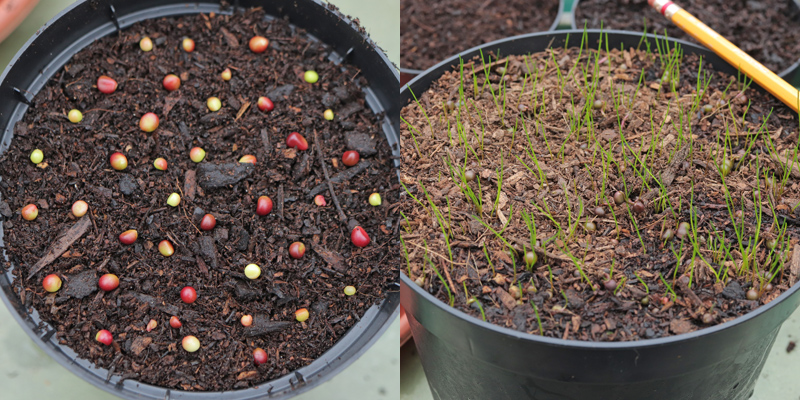
Five.
Begonia bulbils. Begonia grandis ‘Nanjiang Silver’. I have a couple of forms of Begonia grandis which I love, so last year I bought bulbils of a different form from Growild Nursery. When they came I was a bit taken aback at how small the bulbils were and my hopes for anything growing from them were low. I was wrong and I ended up with three plants which this year have produced bulbils of their own, also very small. I have sown them, like seeds. I’m fighting the temptation to collect and sow more of my other B. grandis varieties; I could sell them when we open the garden; why am I fighting?
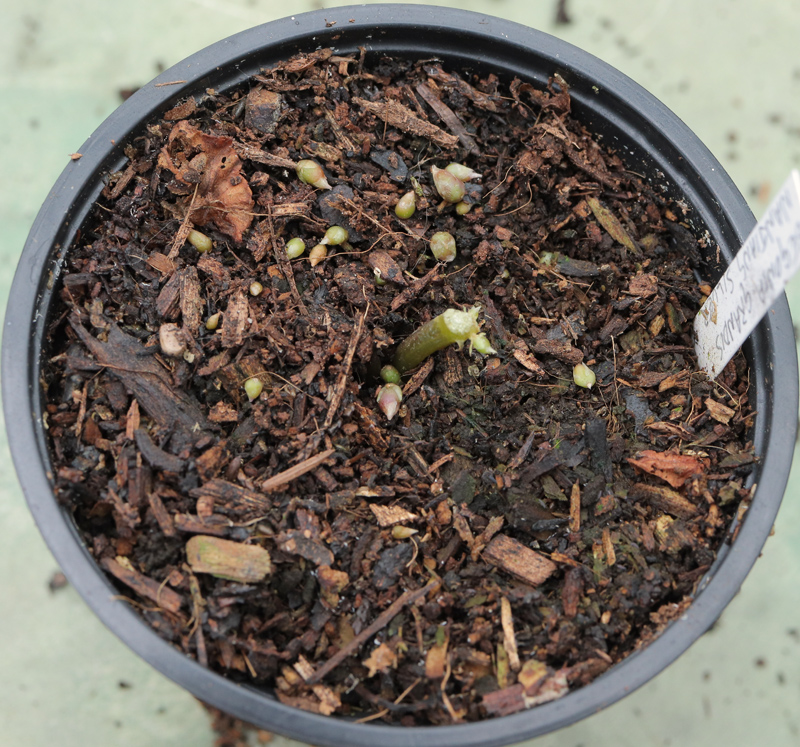
Six.
Rhodochiton atrosanguineus. I am very surprised that this is still looking as good as it is. It’s been a reluctant climber, I kept it in the greenhouse for a long time, training it up a stick, then planted it on our new obelisk where I’ve had to tie it in to get it to grow up. And this is how it repays me, right at the end of October. It has seed pods on it but whether they will yield viable seed remains to be seen; I have bought seed for next year. I can sell surplus when we open the garden.
According to the forecast the weather is going to chuck a bit of everything at us today, but maybe dry up a bit later. It’s still raining and blowing a hoolie at the moment but I live in hope. I just told Sue it would be sunny by 10am, I might get a bit of my fence done, who knows?
I had a quick look at The Prop’s post, he’s the MC for this six on saturday’s gig. If our weather is heading his way he’s going to have a day of decorating.


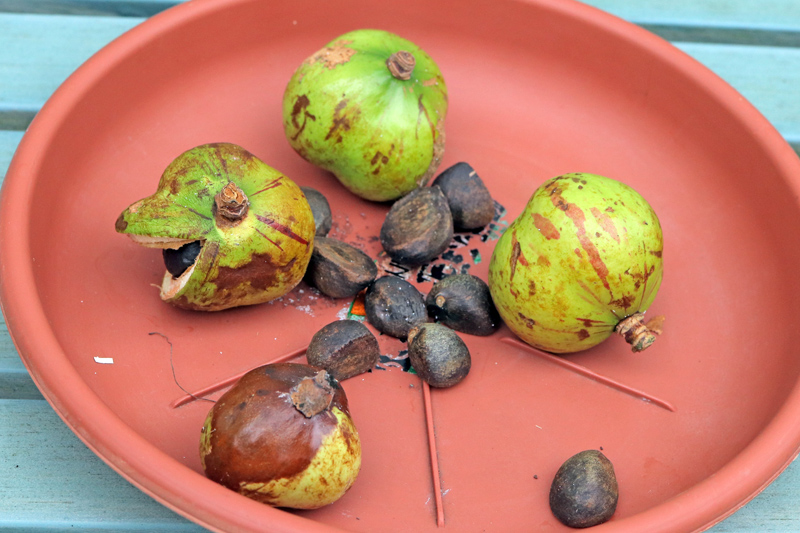
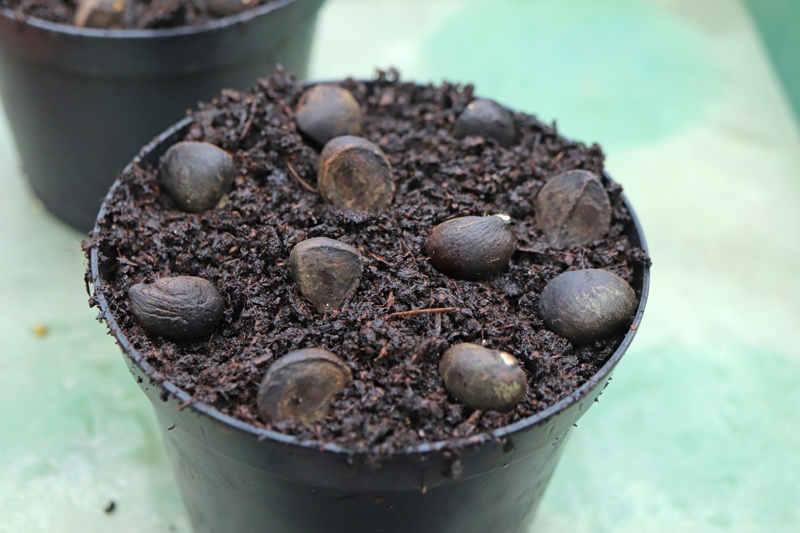

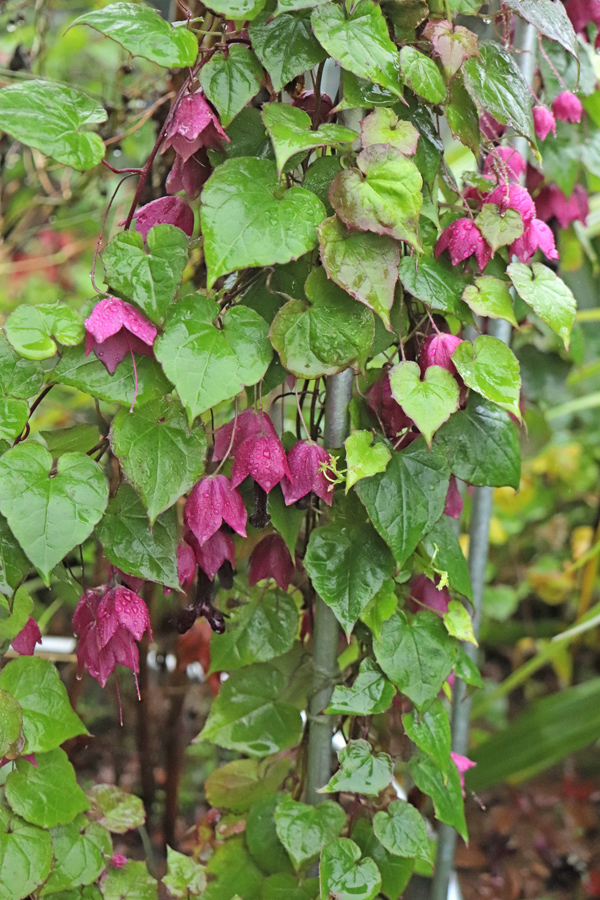
I am sorry I am so late. I may never catch up.
In the acres of camellias we used to grow, I found fruits only a few times, and only on a few cultivars. We grew only a few from seed, and only for the arboretum. None ever got into production.
I must see the Amaryllis belladonna seed next week. I will be sowing the last that ripened late. I have no idea what I will do with what grows, but I can not just discard the seed. Well, I suppose I could discard some back into the landscapes.
LikeLike
In the National Collection of Camellias, where I go to play regularly, there are perhaps a dozen that produce decent quantities of seed regularly, out of around 100 varieties. A couple more produce fruits which usually contain nothing and there are some that produce one or two sometimes. Every year I tell myself that amongst all the seeds is the one that could make my fortune, but sadly I don’t know which seed it is and can only try a very few. I have given the collection back two C. reticulata seedlings I grew from their seed when I was working and had space to grow bigger numbers on. They show promise but only a few seasons growing out in the ground will tell. I have one in the garden here too. It is the hardest thing to throw away seed. It’s the future of life no less.
LikeLiked by 1 person
The only seed that are easy to toss out are the wildflower seed, and only because that is how they get sown. Even they get pampered to some degree, with the soil loosened up a bit fo them to settle into.
LikeLiked by 1 person
Navajo is such a beauty, so enjoy your view! This is my first year digging begonias (and growing them). I plan to store in wood shavings after they dry a bit. Any hints I should know about? Should I mist the tubers?
LikeLiked by 1 person
I’ve always kept begonia tubers dry. Biggest problem I’ve had is vine weevil, if you get them you need to clean the tubers and get rid of any grubs before you store them.
LikeLiked by 1 person
Interesting camellia info, how long to flowering? Seed sowing is such a positive thing to do at this time of year. It can also be a bit of an affliction, there are worse ones though. I don’t envy you your fence building, sure you will do a fine job.
LikeLiked by 1 person
I had Camellia reticulata seedlings in flower in less than two years back in the day. Kept them under potted in 9cm pots in a tunnel. Dumped the uninteresting ones (most) and kept the best few. I’ll try to do the same with these.
LikeLike
The concept of bulbils is intriguing, and I immediately went to look to see how they form and where. Great to see your little seedlings emerging. Do you grow your Nerine’s in your glasshouse to keep them dry? I suppose the sort of wet winter weather we have is not that much to their liking. Hope you get the right weather to work on your fence soon.
LikeLiked by 1 person
I grow N. masoniorum under glass, it’s not reckoned very hardy. If I can build up good numbers I’ll try it outside. Progress was made on the fence today, it doesn’t stay the same for long here generally.
LikeLiked by 1 person
So that lovely Camellia will be flowering throughout Christmas! How lovely.
I’ve looked at the Purple Bell vine in the past but thought it would be too delicate to grow here. I see that it can be bought as ‘jumbo seedlings’ from a supplier I use, and seeing how pretty yours is, it might be worth trying it as an annual.
LikeLiked by 1 person
The Rhodochiton has really surprised me, I hope it wasn’t a flash in the pan. How long the Camellia goes on flowering will be very weather dependent. The mild autumns we’ve had in recent years can mean they’re over relatively quickly.
LikeLiked by 1 person
Not concreting posts in sounds appealing – it took the neighbour and I ages to dig up a snapped fence post a few years ago. The Camellia sasanqua ‘Navajo’ is a beauty.
LikeLiked by 1 person
The down side of not concreting in posts is that you really need to plant them deep. I’m not sure I’d use the word “appealing” about digging a four foot deep hole. The best pro fencer I know never concreted in posts.
LikeLike
A four foot hole? Blimey. Okay, definitely not ‘appealing’.
LikeLike
This is a metre high fence on top of a bank in a pretty exposed spot, running at right angles to the prevailing wind. I’m not taking chances.
LikeLike
I thought the Rhodochiton atrosanguineus was a Clematis when I saw the top photo! It has a lovely colour – it’s an annual for you? Your Admiral Spry sowing is intriguing – looking forward to see what you get!
LikeLiked by 1 person
It’s dawning on me that Rhodochiton might be perennial, I haven’t looked into keeping it over to next year. This is the first year I’ve grown it and I think it’s usually grown as an annual.
LikeLike
The rain has reached London, so the Prop may well be hunkered down with the paint pots. I always had a hankering for a double handled shovel – I have no idea why! I hope your soil is more forgiving then our sodden clay. You are an inspiration in gardening but also in your constant ability of get the best out of block editor. Looking forward to hearing more about the seed sowing.
LikeLiked by 1 person
I have hankerings for tools and try desperately to find a justification for buying them. When I succumb, they’re quite often barely get used. The shovel’s definitely paid for itself, the bar and spade too. The quarry I got my wall stone from is about a mile away so you never know how far down it’s going to turn really stony, no problems on the bank though.
LikeLike
Great to see your seed sowing. I’ve never seen the nerine seeds. How long before they’ll be flowering size?
LikeLiked by 1 person
3-5 years according to the RHS; I just looked because I didn’t have a clue. I sowed some from ‘Ostara’ last year and they’ve grown very well and might be quicker to flower, though that may be wishful thinking.
LikeLike
I didn’t know this tool: the double handled shovel, but it seems very practical to me!
It’s also for me the period of recovery of begonia bulbils : there are so many…
Finally, superb camellia sasanqua!
LikeLiked by 1 person
It’s a very good tool that shovel. I need to collect begonia bulbils before I forget which were white and which pink.
LikeLiked by 1 person
Glad it’s you and not me (us) with the hole digging. We did our bit digging holes for 500 olive trees some years ago! That Camellia sasanqua is a show as will the Camellia japonica be, one day.
LikeLiked by 1 person
500 Olive trees!!!? Do you harvest your own oil now?
LikeLiked by 1 person
The olive trees were on our previous property, Jim and we did pick the olives. By hand, in fact. They produced the most delicious olive oil.
LikeLiked by 1 person
Pretty camellia that doesn’t look like a camellia. Will it keep going whatever the weather? Good luck with the digging, I may not even pick the crabapples it is so wet and windy out there.
LikeLiked by 1 person
The camellia flowers get bruised when its windy but otherwise are very resilient. They put up with bad weather better than I do.
LikeLike
I don’t envy you your outdoor work at the moment. Digging in these conditions is a mess but it has to be done. I’m with you on putting posts in concrete as I’ve also had to replace them over the years and I have sometimes cursed my initial good job. I hope the weather clears up for you to get on with it.
LikeLiked by 1 person
Not a bad day here once the rain passed through. Progress was made.
LikeLiked by 1 person
And not a thing was done here – three rugby games on tv! And Ireland lost Pffffffffffff!
LikeLike
I’d have watched a bit of that too but thought I’d better take advantage of a dryish day.
LikeLiked by 1 person